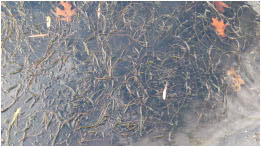Why Do We Care If Non-native Plants Enter Our Water Bodies?
Economic Impacts
The costs to control invasive species are extremely high. Invasive species have the ability to harm native sport fish population. Invasive plants form dense mats that make boating, fishing, and swimming difficult. Zebra mussels encrust piers, lift stations, and boats, sometimes leading to costly repairs. There are preliminary indications that some invasive species can have a negative impact on property values.
Ecological Impacts
Invasive species have the ability to change habitats and threaten the plants and animals that live in them. For example, zebra mussels encrust the shells of our native mussels, making it difficult for them to survive. These invasive mussels also consume the tiny plants and animals that young fish rely on for food. Plants like Eurasian water-milfoil form dense mats that shade out native plant species.
Recreational Impacts
As mentioned previously, invasive plants form dense mats that make boating, fishing, and swimming difficult. Zebra mussel shells that are washed up on beaches can cut the feet of unsuspecting swimmers.
Content last updated on January 7, 2020.

